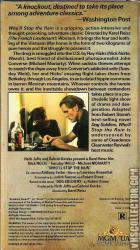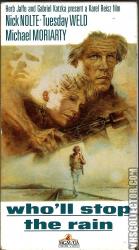Who'll Stop the Rain
Catalog Number
M201306
-
Primary Distributor (If not listed, select "OTHER")
Catalog Number
M201306
Primary Distributor (If not listed, select "OTHER")
Release Year
Country
N/A (NTSC)
N/A | N/A | N/A
N/A | N/A
Who'll Stop the Rain (1978)
Additional Information
Additional Information
Try to rip him off and he'll rip you apart!
A week ago they were strangers. An hour ago they were lovers. Now they are targets.
Thoroughly disillusioned by the Vietnam War, John, a journalist (Michael Moriarty), turns to heroin smuggling. Acting as John's go-between is the equally burnt-out Ray (Nick Nolte), who delivers the narcotics stateside to the journalist's wife, Marge (Tuesday Weld). Soon, however, Ray and Marge are on the lam, chased down by the minions of crooked narcotics agent Antheil (Anthony Zerbe). Who'll Stop the Rain? was based on Robert Stone's award-winning novel Dog Soldiers.
The film is based on Robert Stone's novel Dog Soldiers, which had been winner of the National Book Award (US) for fiction in 1975.[2] For its original US theatrical release it was re-titled Who'll Stop the Rain, after the song by Creedence Clearwater Revival, which features prominently (along with several other popular CCR tracks) on the film's soundtrack. The film was released as Dog Soldiers for release in several foreign territories. Some copies of the DVD of Who'll Stop the Rain actually contain prints titled Dog Soldiers.
Stone based the character of Ray Hicks (Nolte) on Beat writer Neal Cassady, with whom Stone became acquainted through novelist Ken Kesey, a classmate of Stone's in graduate school at Stanford University.
Hicks' death scene on the railroad tracks at the film's conclusion was directly based on Cassady's death along a railroad track outside of San Miguel de Allende, Mexico in 1968. Also, the hippie commune setting, where lights and stereo speakers placed throughout the woods are utilized in Hicks' escape plan, was partially based on Kesey's home in La Honda, California, where Kesey and his friends — known as the Merry Pranksters — famously wired the surrounding woods with lights and sound equipment to enhance their experiments with LSD. Though technically not a commune, Kesey's home was a frequent site for large parties attended by a mixture of literary luminaries such as poet Allen Ginsberg and journalist Hunter S. Thompson, music figures (including Jerry Garcia, whose group The Grateful Dead later became the house band for Kesey's famous Acid Tests), and outlaws, especially members of the infamous Hells Angels motorcycle club. These parties are described intimately in works by Ginsberg and Thompson and in Tom Wolfe's book The Electric Kool-Aid Acid Test. Mention of Ken Kesey, his Merry Pranksters, and Neal Cassady are also discussed in detail in Martin Torgoff's book Can't Find My Way Home.
Release Date: August 25, 1978
Distrib: United Artists
A week ago they were strangers. An hour ago they were lovers. Now they are targets.
Thoroughly disillusioned by the Vietnam War, John, a journalist (Michael Moriarty), turns to heroin smuggling. Acting as John's go-between is the equally burnt-out Ray (Nick Nolte), who delivers the narcotics stateside to the journalist's wife, Marge (Tuesday Weld). Soon, however, Ray and Marge are on the lam, chased down by the minions of crooked narcotics agent Antheil (Anthony Zerbe). Who'll Stop the Rain? was based on Robert Stone's award-winning novel Dog Soldiers.
The film is based on Robert Stone's novel Dog Soldiers, which had been winner of the National Book Award (US) for fiction in 1975.[2] For its original US theatrical release it was re-titled Who'll Stop the Rain, after the song by Creedence Clearwater Revival, which features prominently (along with several other popular CCR tracks) on the film's soundtrack. The film was released as Dog Soldiers for release in several foreign territories. Some copies of the DVD of Who'll Stop the Rain actually contain prints titled Dog Soldiers.
Stone based the character of Ray Hicks (Nolte) on Beat writer Neal Cassady, with whom Stone became acquainted through novelist Ken Kesey, a classmate of Stone's in graduate school at Stanford University.
Hicks' death scene on the railroad tracks at the film's conclusion was directly based on Cassady's death along a railroad track outside of San Miguel de Allende, Mexico in 1968. Also, the hippie commune setting, where lights and stereo speakers placed throughout the woods are utilized in Hicks' escape plan, was partially based on Kesey's home in La Honda, California, where Kesey and his friends — known as the Merry Pranksters — famously wired the surrounding woods with lights and sound equipment to enhance their experiments with LSD. Though technically not a commune, Kesey's home was a frequent site for large parties attended by a mixture of literary luminaries such as poet Allen Ginsberg and journalist Hunter S. Thompson, music figures (including Jerry Garcia, whose group The Grateful Dead later became the house band for Kesey's famous Acid Tests), and outlaws, especially members of the infamous Hells Angels motorcycle club. These parties are described intimately in works by Ginsberg and Thompson and in Tom Wolfe's book The Electric Kool-Aid Acid Test. Mention of Ken Kesey, his Merry Pranksters, and Neal Cassady are also discussed in detail in Martin Torgoff's book Can't Find My Way Home.
Release Date: August 25, 1978
Distrib: United Artists






Comments0
Login / Register to post comments